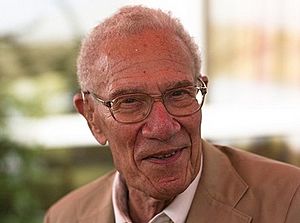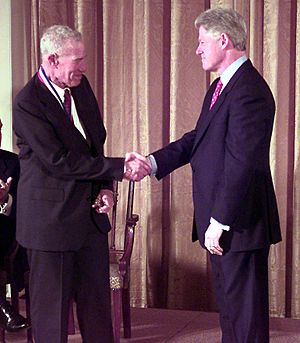Robert Solow facts for kids
Quick facts for kids
Robert Solow
|
|
|---|---|

Solow in 2008
|
|
| Born |
Robert Merton Solow
August 23, 1924 New York City, New York, U.S.
|
| Died | December 21, 2023 (aged 99) Lexington, Massachusetts, U.S.
|
| Institution | Massachusetts Institute of Technology |
| Field | Macroeconomics |
| School or tradition |
Neo-Keynesian economics |
| Doctoral advisor |
Wassily Leontief |
| Doctoral students |
George Akerlof Mario Baldassarri Francis M. Bator Charlie Bean Alan Blinder Vittorio Corbo Peter Diamond Avinash Dixit Alain Enthoven Ray Fair Ronald Findlay Robert J. Gordon Robert Hall Michael Intriligator Katsuhito Iwai Ronald W. Jones Arnold Kling Meir Kohn Glenn Loury Herbert Mohring William Nordhaus George Perry Robert Pindyck Arjun Kumar Sengupta Steven Shavell Eytan Sheshinski Jeremy Siegel Joseph Stiglitz Harvey M. Wagner Martin Weitzman Halbert White |
| Other notable students | Mario Draghi |
| Influences | Paul Samuelson |
| Contributions | Exogenous growth model |
| Awards | John Bates Clark Medal (1961) Nobel Memorial Prize in Economic Sciences (1987) National Medal of Science (1999) Presidential Medal of Freedom (2014) |
| Information at IDEAS / RePEc | |
Robert Merton Solow (August 23, 1924 – December 21, 2023) was an American economist. He won the Nobel Memorial Prize in Economic Sciences for his important work. His research focused on how economies grow over time. He created a famous idea called the exogenous growth model.
Solow was a professor at the Massachusetts Institute of Technology (MIT) starting in 1949. He was given the John Bates Clark Medal in 1961. Later, he received the Nobel Prize in 1987. In 2014, he was awarded the Presidential Medal of Freedom. Four of his students also went on to win Nobel Prizes in economics.
Contents
Robert Solow's Early Life and Education
Robert Solow was born in Brooklyn, New York City, on August 23, 1924. He was the oldest of three children in his Jewish family. His parents were very smart, but they couldn't go to college. Robert did very well in school from a young age.
In September 1940, when he was 16, Solow went to Harvard College. He had a scholarship to help him pay for his studies. At first, he studied subjects like sociology and anthropology. He also took some basic economics classes.
Solow's Time in the U.S. Army
In 1941, Solow left Harvard to join the U.S. Army. He could speak German very well. Because of this, the Army assigned him to a special team. Their job was to listen to German messages, understand them, and send them back to their base.
He served for a short time in North Africa and Sicily. Later, he was in Italy. He was discharged from the Army in August 1945. Soon after returning, he married his girlfriend, Barbara Lewis.
Returning to Harvard and MIT
After the war, Solow went back to Harvard in 1945. He studied with a professor named Wassily Leontief. As Leontief's assistant, Solow helped create the first set of "capital-coefficients" for an input–output model. This model helps understand how different parts of the economy are connected.
He then became very interested in statistics and probability. From 1949 to 1950, he spent a year at Columbia University. There, he studied statistics more deeply. During this time, he also worked on his PhD paper.
In 1949, before going to Columbia, he was offered a teaching job at MIT. He accepted the position in the Economics Department. At MIT, he taught classes in statistics and econometrics.
Solow's Work in Macroeconomics
Over time, Solow's interest shifted to macroeconomics. This is the study of the economy as a whole. For almost 40 years, Solow worked closely with another famous economist, Paul Samuelson. They developed many important theories together. These included ideas about economic growth and the Phillips curve.
Solow also worked for the government. He was a senior economist for the Council of Economic Advisers from 1961 to 1962. His main studies were about jobs, economic growth, and the theory of capital.
In 1961, he won the John Bates Clark Award. This award is given to the best economist under 40 years old. He later became president of the American Economic Association in 1979. In 1987, he won the Nobel Prize for his work on economic growth. He received the National Medal of Science in 1999.
Solow helped start the Cournot Foundation and the Cournot Centre. He also became the chairman of the I.S.E.O Institute. This is an Italian group that organizes conferences and summer schools. He was also a founding member of the Economists for Peace and Security.
Many of Solow's students became successful economists. This includes Peter Diamond, who won a Nobel Prize in 2010. Solow passed away on December 21, 2023, at his home in Lexington, Massachusetts, at age 99.
Solow's Model of Economic Growth
Solow's most famous work is his model of economic growth. It is also known as the Solow–Swan neoclassical growth model. Another economist, Trevor Swan, developed a similar model at the same time. This model helps us understand what makes an economy grow.
It shows that economic growth comes from two main things. First, it comes from increases in inputs like workers and machinery. Second, it comes from technological progress. This means new and better ways of doing things.
These models are called "exogenous" growth models. This means that the rate at which people save money is assumed to be given from outside the model. Solow's model showed that about four-fifths of the growth in output per worker in the US was due to new technology.
Solow also thought about how new machinery (capital) is different from old machinery. He believed that newer capital is more valuable. This is because it's made using the latest technology. This idea is called "vintage capital." New technology is always getting better. So, new machines are more productive than older ones.
To make his ideas easier to understand, Solow used a graph. The graph shows "capital per worker" on one side and "output per worker" on the other. This helps explain how much a country can produce based on its capital.
The graph has different lines. One line shows how much output is produced for each level of capital. Another line shows how capital wears out over time. A third line shows how much savings and investment are needed.
The point where these lines meet is called the "steady state level." This means a country is producing just enough to replace its old capital. Countries that are far from this point grow faster. Countries that are past this point might not grow much. This is because all their earnings go to fixing old capital.
Since Solow's work in the 1950s, many new growth models have been created. These models explore different reasons for economic growth. For example, some models look at how people decide to save money. In the 1980s, economists started focusing on the role of technology. This led to the idea of endogenous growth theory. Today, economists still use Solow's ideas to study how technology, capital, and labor affect economic growth.
As of 2022, Solow was still a professor at the MIT economics department. He also taught at Columbia University earlier in his career.
MIT Economics: A Hub for Growth Theory
In the 1960s, MIT was a very important place for economists studying growth. Paul Samuelson, a leading economist at MIT, wrote a famous textbook. In a later edition, he added a new chapter about growth theory. This showed how important Solow's work was becoming.
The economists at MIT were interested in growth for two reasons. First, they saw economic growth as a very important goal for countries. Second, they saw the study of growth as a key area for economic research. Solow's model was a perfect example of their style of thinking. It provided a clear way to study growth. This made MIT a central place for growth theory in the 1960s.
Honors and Awards
 Grand-Cross of the Order of Prince Henry, Portugal (September 27, 2006)
Grand-Cross of the Order of Prince Henry, Portugal (September 27, 2006)- Member, American Academy of Arts and Sciences (1956)
- Member, United States National Academy of Sciences (1972)
- Member, American Philosophical Society (1980)
See also
 In Spanish: Robert Solow para niños
In Spanish: Robert Solow para niños
- List of economists
- List of Jewish Nobel laureates
- Backstop resources
- Basic income
- Growth accounting
- Solow Growth Model
- Solow residual
- Guaranteed minimum income


